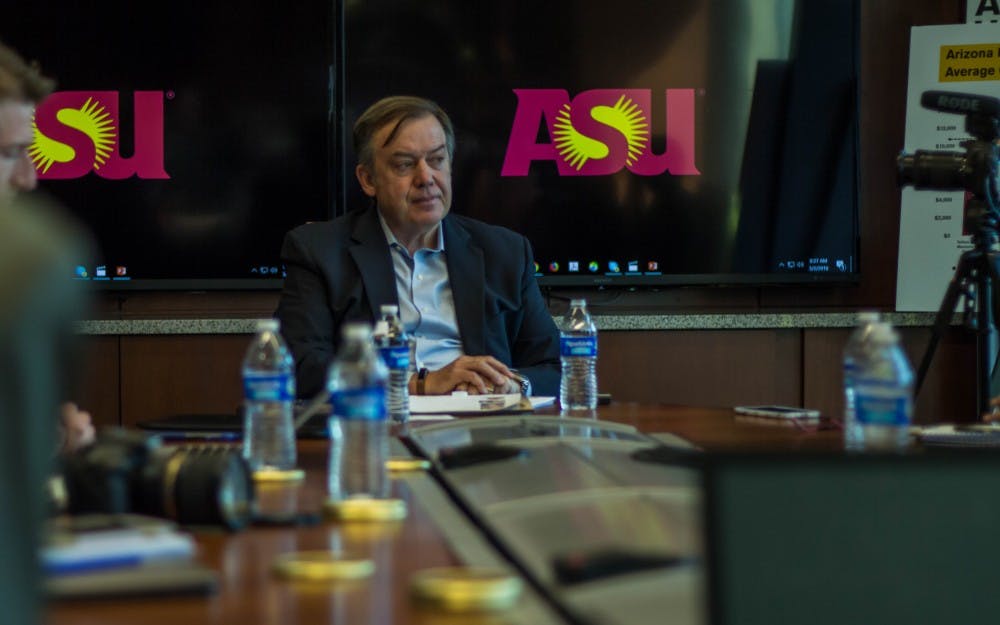It has been 16 years since Michael Crow became president at ASU, and the University has grown significantly in that time.
According to official and unofficial enrollment records and projections from ASU, the number of students attending the University has increased by about 89 percent during Crow’s tenure, rising from just over 57,500 students in 2003 to 109,000 in 2018.
This jump has far outpaced comparable universities nationwide and surprised experts who say that national enrollments have already hit their peak.
When Crow arrived at ASU, the Polytechnic, Tempe and West campuses were the only functioning locations for the University. Since then, the University has added downtown Phoenix and Thunderbird campuses as well as the SkySong Center in south Scottsdale. The rapid growth of the newer satellite campuses has been a driving force behind ASU’s skyrocketing enrollment numbers, according to enrollment data.
The growth of the SkySong campus is particularly noteworthy. After opening in 2010 with 520 students, the campus now boasts an enrollment of over 31,000, an increase of nearly 6,000 percent. Skysong hosts a business incubator, entrepreneurial programs and the headquarters for ASU Online.
Even more, the development of the downtown Phoenix campus, as well as an influx of out-of-state students, has fueled ASU's transition to one of the country's largest research universities.
The growth has trickled down to ASU's individual schools and colleges, especially the Ira A. Fulton Schools of Engineering. The Fulton Schools, which include six individual colleges spanning multiple campuses, is now the largest specialized program at ASU by enrollment, data shows.
But it wasn't always that way. In fall 2004, two years after Crow’s arrival, just under 7,500 students were enrolled, according to University data. Since then, the school has ballooned in size to around 16,000.
Stephanie Mabee, associate director of engineering communications, said that ASU’s size allows the Fulton Schools to innovate engineering curriculum by interacting with other large colleges at the University.
“President Crow’s access mission for the University really opens the door to many students coming in to get degrees,” she said. “Whereas students may not have come to college before, now they are, and they are finding what they are truly interested in and pursuing that.”
At ASU, “you’re very aware of the force that we have become in the nation and the region," she said.
However, while ASU as a whole is growing, some schools are struggling to keep up. One of those is the Mary Lou Fulton Teachers College.
Enrollment grew to over 6,500 in 2008, but nine years later, the school’s enrollment sat at about 2,800, according to University records.
While the Teachers College is losing students, Paul Gediman, executive director of marketing and advancement for the college, said he is not too concerned.
“Nationally, the degree production in the field of education has decreased,” he said. “This is not just an issue at ASU — we’re actually doing better than most.”
Gediman added that economic stress stemming from the Great Recession in 2008 has also hurt the national teaching industry.
Despite huge gains in enrollment, the University appears to have maintained academic standards. The student-to-faculty ratio has actually gone down, from 1-to-21.8 in 2007 to 1-to-20.2 in 2017.
In that time, the University's research expenditure has more than doubled, up to $546.5 million in the 2017 fiscal year, according to University statistics.
Nationally, ASU is growing faster than other schools of similar size
When compared to other large public universities, such as University of Central Florida or The Ohio State University, ASU's growth still stands out.
Based on official data released between 2003 and 2017, ASU's enrollment increased by nearly 80 percent in that time period. The next closest large public university is Florida International University, which has grown by just under 70 percent. Its current enrollment is around 53,000.
ASU's growth has also outpaced its neighbors in Tucson and Flagstaff. Enrollment at the University of Arizona has increased by just over 20 percent and enrollment at Northern Arizona University has increased by almost 62 percent between 2003 and 2017.
Since Michael Crow became president, ASU has also overtaken Penn State and Ohio State to become the largest university in the United States by enrollment, which includes undergraduate, graduate and online students.
In 2017, ASU came in at over 103,000 students, while Penn State's enrollment was just under the 100,000 mark, official data shows. It's important to note that ASU, while not a part of a state University system, has multiple campuses throughout the Phoenix metro and a massive online presence, which contributes to its enrollment.
Trey Chappell, founder and director of College X-ing, a company that specializes in college preparation for high school students, said that ASU's growth is unusual compared to national trends.
"(ASU) is at the front of the line in terms of enrollment growth and drawing students in for a number of different reasons," Chappell said.
He said the University has proven to be flexible and forward-looking, which has helped it grow.
ASU's willingness to expand into spaces like the internet allows them to continue growing. Smaller, more rigid programs struggle to expand into those areas because they want to maintain tradition or prestige, Chappell said.
It's especially remarkable because nationally, university enrollments reached their peak two or three years ago, when a record amount of students graduated high school.
But while the Tempe campus has maintained a relatively stable population, enrollment University-wide shows no signs of slowing down.
"ASU has the advantage of being a big research university that has a lot of different flexibility in their programming," he said. "They have the flexibility to grow in areas that have more demand."
Reach the reporter at nkhedges@asu.edu and follow @nicktrimshedges on Twitter.
Like The State Press on Facebook and follow @statepress on Twitter.




